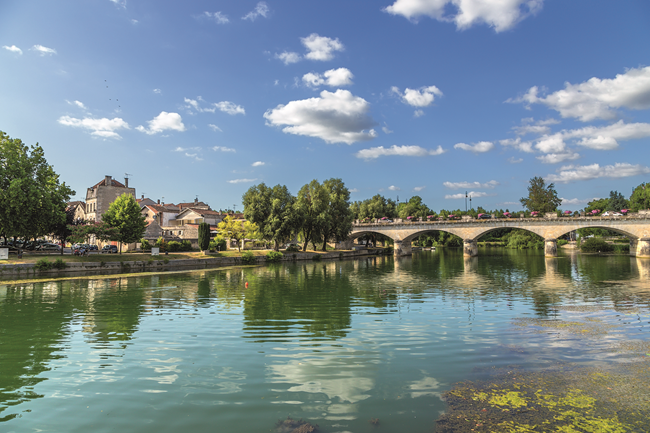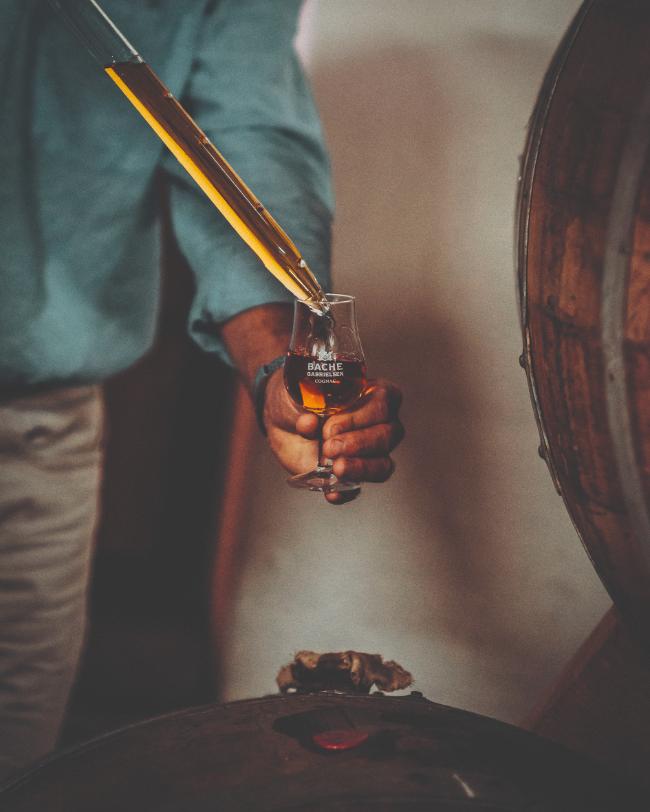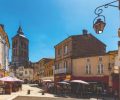City Breaks in France: Cognac
Despite Cognac the beverage’s luxury status and worldwide renown, Cognac the town remains refreshingly authentic and a delightful place to visit, free of crowds and chains stores.
On the scenic drive from Saintes to Cognac, gently sloping vineyards extend as far as the eye can see, their new April growth glimmering emerald against the Charente department’s famously limpid skies, towering white clouds billowing in the background. This is my glorious introduction to Cognac, France’s most voluminous grape- growing region – or six regions, to be precise – extending from the Île de Ré off the Atlantic coastline to Angoulême and beyond, with the medieval town of Cognac in between.
The small white grapes that have thrived here since Roman times produce a juice too tart to make fine wines but are hardy enough for the twice-distilled brandy that takes its name from the region and the town. Like Bordeaux, Bourgogne and Champagne, no other drink in the world can call itself Cognac – and who would dare? This famously elegant brandy is one of a kind, ranging in colour from a rich, luminous gold to deep, jewel-like amber, depending on its age. Kept for a minimum of two years in barrels made from oak trees harvested in the nearby Limousin forests, Cognac’s delightful and dizzying palette of aromas includes everything from apricot, orange blossom, peach and honeysuckle to caramel, licorice, coffee, fresh truffles and tobacco.
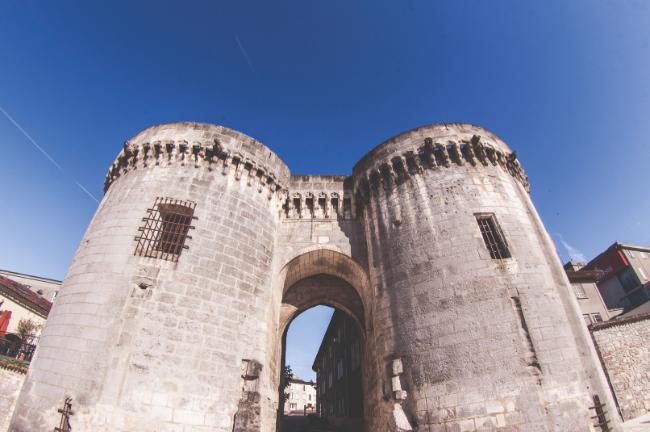
Porte Saint Jacques Cognac © Jennifer Ladonne
“What makes Cognac unique in the world are the aromas from the soil,” says Jean-Pierre Bergier, master blender at the 120-year-old Cognac house Bache Gabrielsen since 1989. Looking every bit the alchemist against a backdrop of dozens of bottles of Cognac elixirs in his circa 1900 office, he explains he might use anywhere from three to 20 different vintages in his Cognacs, from as many different vineyard parcels, to achieve the round and supple Bache Gabrielsen house style. But it’s the distillation process, carried out in a series of outlandishly shaped copper stills that makes Cognac one of a kind. “Distillation is extremely aggressive. We boil the wines for over 12 hours, and then we do it for a second 12 hours to concentrate the aromas slowly without destroying anything.” By contrast, the best whiskies are distilled for two hours.
The resulting eaux-de-vie are stored in barrels for an ageing process that can last anywhere from two to 50 years, or even longer. Cognac continues to grow in complexity and smoothness as long as it’s in the barrel, and for Bache Gabrielsen’s most rarefied blends, Bergier draws from nectars dating back to the founding of the house in 1906.
Descending into the dank, dark subterranean cellars rendered even duskier by the black mould that populates the walls and casks, my guide at Baron Otard, set in Cognac’s picturesque medieval château, leads me to paradise. That’s the name for the inner sanctum of every Cognac house where the oldest elixirs are stored in giant oblong glass bonbonnes nestled in straw baskets, some dating as far back as the mid-19th-century. Unlike fine wines, which continue to age in the bottle, Cognac’s ageing process ceases once the liquor is in glass.
I’m invited to sample a ten-year-old Cognac ready for bottling. But I hardly need a taste: the 40 to 70 per cent alcoholic fumes emanating from nectars ageing in hundreds of stacked oak barrels is heady enough. “La part des anges,” the angel’s share she explains, the roughly three per cent of evaporated eau-de-vie sacrificed to the air, representing about 34m bottles a year. A staggering number, but given that 212m bottles were shipped globally in 2022, and many millions more are stored by the barrel in Cognac’s hundreds of houses, it’s a hazard of the trade and in more ways than one. So many barrels of the ageing eaux-de-vie rest in the town’s subterranean network that Cognac is obliged to set laws limiting the number that can be safely harboured within city limits too many and they risk being blown sky high in the event of a fire.
Despite Cognac the beverage’s luxury status and worldwide renown, Cognac the town is refreshingly free of high-end boutiques and global chains. In the glory of spring, it is also free of tourists. Even in high season, Cognac will never approach the crush of people in the towns of nearby Dordogne or the Loire, as most visitors are here to trade or are Cognac enthusiasts. Maybe that’s why its lovely old town, hewn from the creamy white local limestone, retains a charm and authenticity that makes its cobbled streets a dream to wander. In a delightful two hours you can wander from Place François le (named after the Renaissance king, who was born in the Château de Cognac), past the old town’s half-timbered medieval townhouses and Renaissance façades, to the graceful 12th-century Saint-Léger church with its 15th-century Gothic rose windows, stopping in at Chocolaterie Letuffe for a taste of their handmade Cognac- perfumed chocolates and Le Gourmet Charentais grocer to stock up on all the local specialities, including Cognac. In the halls of Cognac’s soaring Belle Époque-era covered market I discover the first luscious strawberries of spring, neat rows of asparagus and the stacked leaves and delicate flowers of local bear’s garlic. On weekends, you can slurp fat Cocollos oysters and sample briny Sturia caviar, farmed in nearby Saintes.
The highlight, of course, is the centuries-old Cognac houses themselves. Their stately mansions lining the beautiful Charente River and tasting rooms scattered around town offer a range of dégustations and visits and even a lazy river cruise.
Back at the Chais Monnet hotel and spa, an elegant ancient- meets-modern structure set in the former storage houses of the historic Monnet Cognac house, I perch on a high stool in the chic Jazz bar to discover another aspect of the local alchemy – the Cognac cocktail. The barman’s ambrosial concoctions are uniformly sublime, but my favourite is the Sidecar, a refreshing mix of hand-squeezed lemon juice, Cointreau (a brand of triple sec owned by Cognac house Rémy Martin), and VSOP Cognac aged between four and nine years (XO is aged ten to 13 years; XXO 14 on up, then come your Napoléons, Reserves and Hors d’Age bottles, cellared anywhere from 30 to 100-plus years).
Chais Monnet is also home to Les Foudres, Cognac’s only Michelin-starred restaurant. Take your time over a masterful dish of John Dory, Russian kale and local morels flecked with a brilliant green pesto made from wild bear’s garlic; or balsamic- glacéed pigeon so tender it melts in the mouth, its velvety goodness highlighted by a tangy beet purée and rose peppercorns. Dessert is a towering lemon soufflé accompanied by, you guessed it, a glowing snifter of the local best.
From France Today Magazine
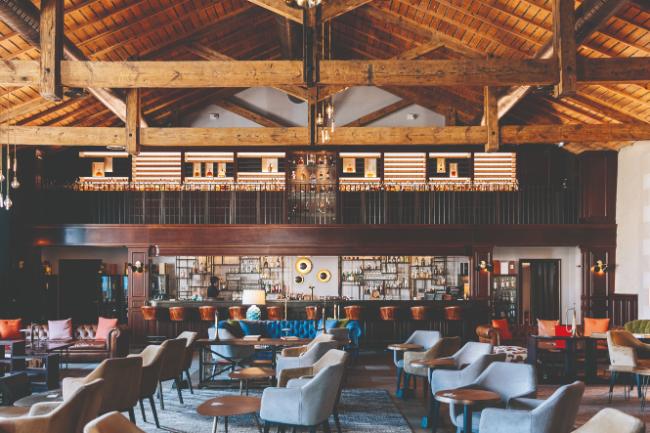
Chais Monnet Jazz Bar by Solène Guillaud © Chais Monnet
Lead photo credit : The Charente river flowing through Cognac © Shutterstock
Share to: Facebook Twitter LinkedIn Email
More in aquitaine, city break, city breaks in France, cognac
Leave a reply
Your email address will not be published. Required fields are marked *

